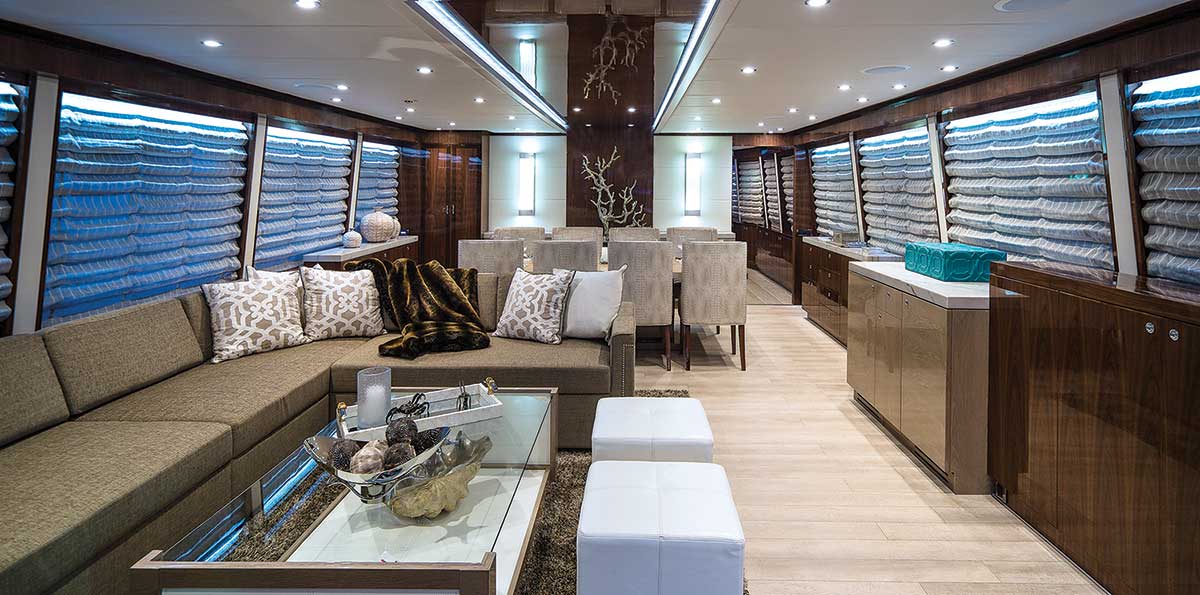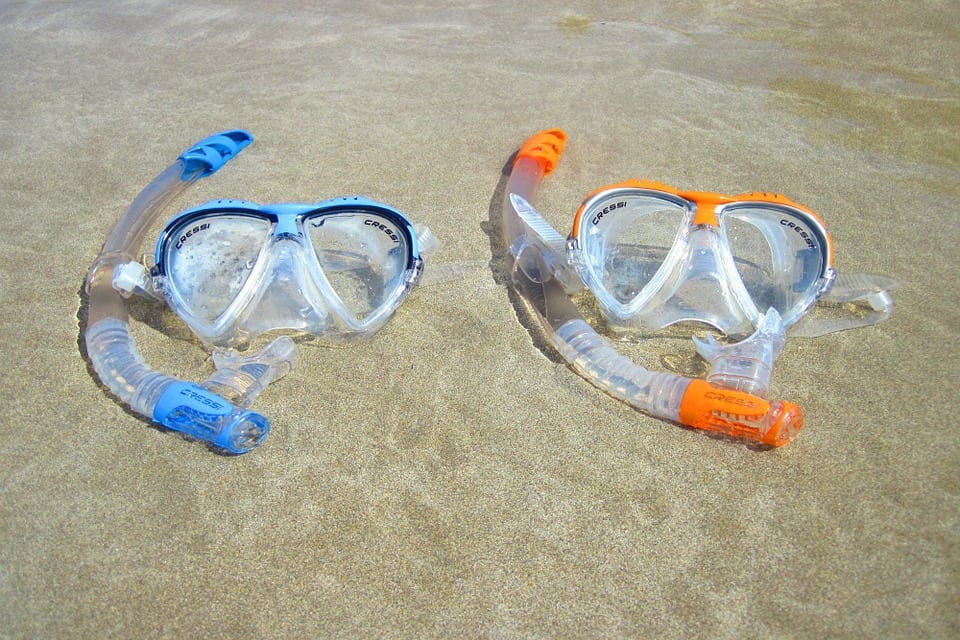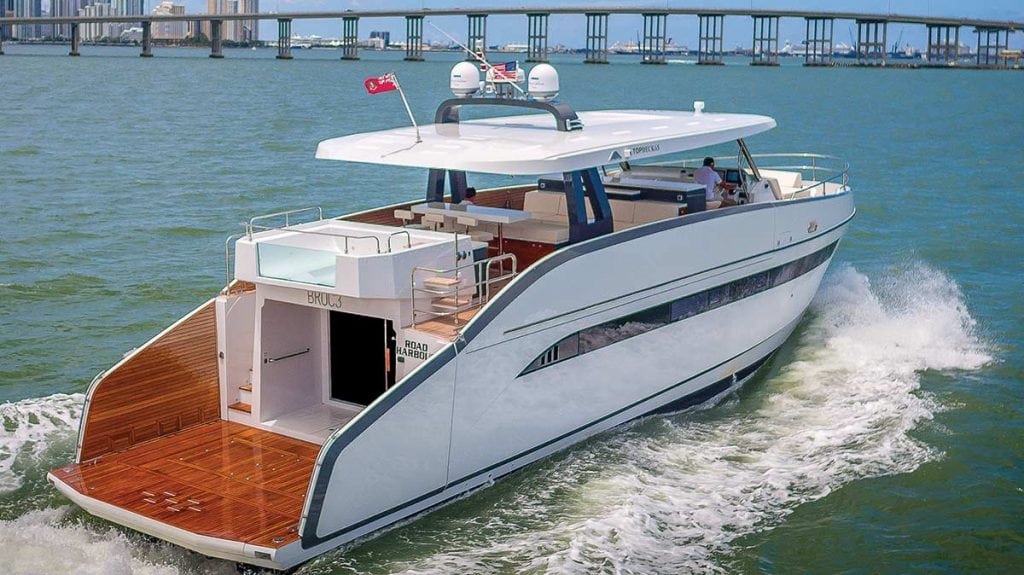Ready to redecorate?
Here’s what’s new in yacht interior design and décor.
Walk around any boat show and you’ll notice that yacht décor and interior design are evolving as fast as the underlying naval architecture. Influenced by both shifting tastes and new technology, yacht interior trends change every 3-8 years, which has repercussions on the sale of new vessels as well as the resale value of pre-owned yachts.
Interior designers experienced with marine applications must combine form and function seamlessly for the demanding environment. Space must be used effectively, weight is kept to a minimum and a boat usually takes much more wear and tear than a house. With the addition of large sunroofs, disappearing doorways and well-appointed flybridges, the line between the indoors and outdoors is blurred so materials must be as seaworthy as the crew.
Shelley DiCondina of Yacht Interiors by Shelley, frequently works with Hargrave Yachts where an interior project can take 16 months. Her designs must anticipate what will be stylish nearly a year and a half after she develops the concept and for the many years that the owners will enjoy their vessel. Textures, light, space planning, and the scale of furnishings must work in harmony, meaning serious décor is far beyond adding a few throw pillows. An awareness of trends is critical.
Color Consistency
The most noticeable trend is in color. Clients are leaning toward neutrals—gray, black and mineral tones—that can be mixed and matched easily and use bold color only for small accents according to DiCondina. She speculates that people are using a neutral palette to create a calm respite with their décor and counteract their world of high-stress jobs, social discourse and shifting political environments. As in real estate today, gray is dominant but it’s often accented with soothing rose or coral ornaments.
In wood tones, walnut has popped up everywhere, whether on 100-foot superyachts or 50-foot production boats. Interpretation of the shade varies, but the trend is unmistakable. A stroll through new models at the 2016 Fort Lauderdale International Boat Show also underscored the return to high-gloss finishes on paneling and cabinetry.
Color is heavily influenced by lighting, which is almost entirely LED-based. Thanks to technology, five shades of white are now available in LEDs, which is paramount since what works in a showroom may turn greenish or blue once aboard. Instead of ornate chandeliers, indirect lighting has become popular with light cords hidden behind valences and under furniture edges for a soft glow effect.
The use of natural or synthetic stone (think Silestone) is still de rigeur, but gone are the marbled colors, specs, flecks, and sparkle of yesterday’s slab granite. Instead, white and off-white countertops highlight a cleaner, sleeker aesthetic.
Design Detox
The amount of décor and the hiding of the details of functional spaces trend toward minimalism, an overused yet appropriate term. Stylish stainless-steel appliances are on both power and sailboats, but today these galley tools are hidden by cabinetry and camouflaged with both soft and hard surfaces, so you can hardly tell where meals are prepared. (Service galleys on crewed yachts are an exception, but even they are sleeker than before.) Televisions disappear into furniture or behind artwork, and even switches, outlets and charging ports have been hidden inside or below some other feature. Décor has become spare but innovative. DiCondina makes note of a six-foot band of walnut she added to a ceiling to add contrast. A single silver tree sculpture was added to tie the two together for a simple, elegant effect.
Form and Function
Fabrics are the workhorses of innovative décor, and with high-end textiles there is very little difference between indoor and outdoor materials. DiCondina’s expansive library of Sunbrella sample fabrics includes chenilles with pearl and beading accents that can be used for interiors and also withstand exterior exposure in the cockpit or on a sunpad.
A special nod goes to bedding; you will not find a bedspread on a stylish yacht today. Instead, quality linens, high thread count Egyptian cottons, duvets, and cashmere coverlets adorn the beds in master staterooms. Colors are often matched to wall coverings and stone surfaces in individual cabins. Even crew quarters on larger yachts are becoming increasingly posh with larger spaces, granite accents and flatscreen TVs.
Quieter by Design
Finally, functional décor is also about sound attenuation. “If you’ve ever had a vague sense of discomfort aboard but don’t know why, it may be due to fatigue from noise,” says Sylvia Bolton of Sylvia Bolton Design. She adds that noise can be managed on a new boat or added as aftermarket, which often gives an older boat a facelift. “Sound is carried by or bounced off of every boat surface from built-in cabinetry to those beautiful teak and holly cabin soles, and everything is always in some form of motion.”
First on the silence-is-golden list is carpeting. Since many engine rooms are situated under the salon, the underlayment is critical. Rubberized padding dampens vibration and deadens sound. For boats with hardwood flooring, DiCondina has used synthetic felt underlayment to dampen noise, and area rugs are a great way to break up hard spaces.
Walls and bulkheads can also be softened with fabric treatments. One contemporary go-to for Bolton is leather-covered panels that look modern but serve to keep things quiet. Hair-on-hide treatments with stamped or painted leather are popular as well, according to DiCondina.
Master staterooms often butt up to the engine room, which can be a specific noise challenge. Some architects place the head between the engine room and the stateroom, but if your boat isn’t laid out like that, adding soft materials will help. Putting a padded leather headboard on the master bed and adding fabric-covered acoustic headliners on the ceiling of cabins can do wonders. The best part is that these can be done in modular panels and changed out if damaged or when the décor needs to be refreshed.
DiCondina advises against making your boat a replica of your home, since your boat is a getaway and should be an inspired oasis designed to bring you together with nature. Letting the surroundings speak for themselves is always a good way to go.
By Zuzana Prochazka, Southern Boating Magazine January 2017














